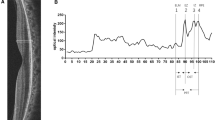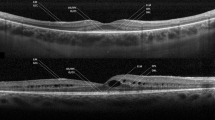Abstract
Background
To report the changes in the optical coherence tomography (OCT) images of the outer retinal layers after prolonged dark adaptation in a patient with Oguchi disease.
Case
A 75-year-old woman showed the typical golden-yellow fundus reflex of Oguchi disease, and the coloration returned to normal after prolonged dark adaptation. Fourier domain OCT (FD-OCT) was performed on the patient’s left eye before and after prolonged dark adaptation.
Observations
Before dark adaptation, the FD-OCT images at the fovea had three identifiable reflection bands, namely, the external limiting membrane (ELM), the border between the photoreceptor inner and outer segments (IS/OS line), and the retinal pigment epithelium (RPE)/Bruch band. The paramacular area had only the ELM and RPE/Bruch bands. After 4 h of dark adaptation, the IS/OS line was also detected in the paramacular area.
Conclusions
The absence of the IS/OS line in the extramacular regions in the partly dark adapted condition was most likely due to a defect in the rod photoreceptors of this area. The emergence of the IS/OS line after prolonged dark adaptation suggests that microarchitectural changes occur in the photoreceptors and that the changes may be correlated with the improvement of rod function.
Similar content being viewed by others
References
Matsumoto H, Kishi S, Otani T, Sato T. Elongation of photoreceptor outer segments in central serous chorioretinopathy. Am J Ophthalmol 2008;145:162–168.
Zawadzki RJ, Choi SS, Jones SM, Oliver SS, Werner JS. Adaptive optics-optical coherence tomography: optimizing visualization of microscopic retinal structures in three dimensions. J Opt Soc Am A Opt Image Sci Vis 2007;24:1373–1383.
Usui T, Ichibe M, Ueki S, et al. Mizuo phenomenon observed by scanning laser ophthalmoscopy in a patient with Oguchi disease. Am J Ophthalmol 2000;130:359–361.
Miyake Y, Horiguchi M, Suzuki S, Kondo M, Tanikawa A. Electrophysiological findings in patients with Oguchi’s disease. Jpn J Ophthalmol 1996;40:511–519.
Bizheva K, Pflug R, Hermann B, et al. Optophysiology: depthresolved probing of retinal physiology with functional ultrahighresolution optical coherence tomography. Proc Natl Acad Sci U S A 2006;103:5066–5071.
Author information
Authors and Affiliations
Corresponding author
About this article
Cite this article
Yamada, K., Motomura, Y., Matsumoto, C.S. et al. Optical coherence tomographic evaluation of the outer retinal architecture in Oguchi disease. Jpn J Ophthalmol 53, 449–451 (2009). https://doi.org/10.1007/s10384-009-0708-1
Received:
Accepted:
Published:
Issue Date:
DOI: https://doi.org/10.1007/s10384-009-0708-1




